四年级年级unit 4共案表格
四年级英语下册Unit 4英文教案表格式
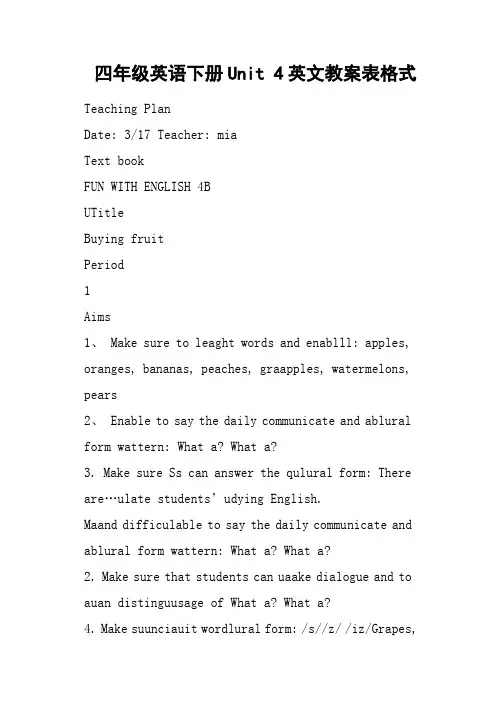
四年级英语下册Unit 4英文教案表格式Teaching PlanDate: 3/17 Teacher: miaText bookFUN WITH ENGLISH 4BUTitleBuying fruitPeriod1Aims1、 Make sure to leaght words and enablll: apples, oranges, bananas, peaches, graapples, watermelons, pears2、 Enable to say the daily communicate and ablural form wattern: What a? What a?3. Make sure Ss can answer the qulural form: There are…ulate students’udying English.Maand difficulable to say the daily communicate and ablural form wattern: What a? What a?2. Make sure that students can uaake dialogue and to auan distinguusage of What a? What a?4. Make suunciauit wordlural form: /s//z/ /iz/Grapes,peawords pronounce/z/.AidsPictu: Free talkT: W? Pleadu: Thi s is…T: Nu.T: How are you today?Ss: Fine, and you?Step 2 Warming upToday’ake alude “today”.T: What mouw?Ss: It’s April.T: What da?S: It’s …th.T: Oh, Liu Tao’s birthdag soon. Let’s garket and bugarty. OK?Ss: Ok.T: Let’s buuit.T: What’s th is? (T writes down)S1: It’s an apple.T: Very good. What’s this?S2: It’s an apple.Song: An apple a dadoctor away.T: An applugh. We need some apples.T: A-p-p-l-e-unces /z/ Ss read follow me.T: They’re applad follow me. (T writes down)T: What colour are they?Ss: They’re red.2)T: What’s that? (T writes down)Ss:It’s an orange.T: We needanges.T: 1磅=pound (1 p)5元/千克:five Yuan a kilo (5元/Kg)3.5元/磅:three Yuan five Jiao a pound (3.5元/p) 2.Can I help you? I’d l….How many kilos? …kilos, please.T: Now, I’m a shop assistant. You can buy fruan I help you?S: I’d like apples.T: How many kilos?S: Two kilos, please.T:u are.S: Thank you. Goodbye!T: Bye!T-ST: I also like to buuather andWho’d like to bassistant?S: I try.T: OK. You, please.S1: Can I help you?T: I’d lawb: How many kilos?T: One kilo, please. How much are they?( Take out the pudludent understand the meaning)S1:Ten Yuan.T: Here you are. And I’d lugar caa: How many kilos? T: Three kilos, please. How much are they?S1: Ten Yuan.T: No, eight Yuan.S1: OK.T: Here you are.S1: Thank you. Goodbye!T: See you.S-T S-PracticeT: Now I’ll divide youur groups. You can dglaThe studgroup one aassistants in Lianhua supermarket. Group two aassistants in Rt-market. Grouand four auu can go now.S: (Dg.)T:udgroup one and group two also like to buulet’s exchange now. The studgrouaassistants in Lianhua supermarket. Group four aassistants in Rt-market. Group one and two au: (Dg.)lidationT: Now pleaur books and turn to page 31. Let’s read aape. Are you ready?S: Yes.T:we go.S: ( Read aaad in groups/ pairs.)Today we have learnt how to buy fruglish. That’s all for toda:HomeworkOral work: 1) Read page 30-32 aape.2) Prepare Part D, make a new dialogu: Design of writing:Unit 4 Buying fruitWhat a/ those?They’re …I’d l…How many kilos?… kilo(s), please.Here you are.ResourcesFun with English VCDPDate: 3/23Text bookFUN WITH ENGLISH 4BUTitleBuying fruitPeriod3AHelp studake new dialogues according Part A.2. To use pattern drills to madialogues3. To cultivalearning English anduunicating in English.Maand difficul:(1) What a/ those?(2) They’re …(3) I’d l…(4) How many kilos?(5) …kilo(s), please.(6) Here you are.The students can make the dialogues fluently. AidsPictures, tader, maWarming-up and revReview the chant I like fruitsI like fruitApples, applesRed and sweet.I lat.Bananas and pears,Green and yellow.Eaw.2. Review how to salos andT: How much a kilo? ( Take out the card: 5元/Kg)S: Five Yuan a kilo.T: How much two kilos?S: Ten Yuan two kilos.T: How much a pound? ( Take out the card: 2.5元/p) S: Two Yuan five Jiao a pound.T: How much four pounds?S: Ten Yuan four pounds.T: (More practice.)Step 2. PresentationT:udents toldaven’t bought fruits last class. So let’s give them a chaulease.T: Can I help you?S1: I’d lawbgrandT: OK. How many kilos?S1: One kilo, please.T:u are.S1: How much are they?T: Eight Yuan five Jiao.S1:u are.T: Thank you. Goodbye!S1: Bye-bye!T-S S-New structures learning1. How about…? Here’T: OK, all of us have bought thinglaw. I’m very haI forgant thing, I haven’t bought thingu, my students. I must bug for you. Who can bassistant now?S: I try.T: OK, you please.S1: Can I help you?T: I’d like to buugar caudents. How much a kilo? S1: Six Yuan a kilo.T: En, how about five Yuan a kilo?S1: OK. How many kilos?T: LFive kilos, please.S1: Here you are.T: How much are they?S1: Twenty-five Yuan, please.T: Here’: Thank you. Goodbye!T: See you!T-S2. T? The …lease.T: I have bougugar caud’a vy. I still want to buapples and strawbudents. Who can bu?S: I try.T: OK, you please.T: (Act aassistant.) Can I help you?S2: I’d like to buapplacher.T: T? (Papples.)S2: The big ones. How much a kilo?T: The big ones auan a kilo.S2: Five kilos, please.T:u are. Fifty Yuan, please.S2: Here’T: Thank you. Goodbye!S2: Bye!S-TPracticeT: Thank you. You’ve done a good job. Now, class,I’ve opened a company. The cuan book all kinds of fruI have to buuwlging. I have to answlWho can buuardw?S: I try.T:ard u. … (Give the cardudents.)Card 1: apples 3元/Kg 2 kilosCard 2: pears 2.5元/Kg 4 kilosCard 3: Strawb元/Kg 1 kilo…S-lidationS: HanduT: Thank you very much. The fruits au. That’s alllHomewal work: Read and practice Unit 42.Written work:w words and drills.3. The Ss who has already well grasped 2 can challengllowing work:Make new dialogues based on Part D in grou: Design of writing:Unit 4 Buying fruitWhat a/ those?They’re …I’d l…How many kilos?… kilo(s), please.Here you are.ResourcesRbookPDate: 3/24Text bookFUN WITH ENGLISH 4BUTitleBuying fruitPeriod4AReview the pattern drills: What a/ those? They’re … I’d l… How many kilos? … kilo(s), please. Here you are. Try to make new dialogues wabovly and properly2. Daily communications and ex: Can I help you? T? …Yuan, please.3. Pay aduncia“th”Maand difficulThe pronuncia“th”2. What a/ those? They’re … I’d l… How many kilos? … kilo(s), please. Here you are.AidsPictures, tadWarming-up1. Touch and guess: What’s this/ that? What a/ those? A…?2. Make new dialogues aboug in groups. GivaRhyme T: Do you like fruit?S: Yes, I do.T: What do you like?S: I like …Let’s learn a rhyme I like fruit.Try to make newwwords we learned.Apples, apples, red and sweetBananas, bananas, green and yellowLemons, lllow and sourGrapes, grapes, purple and greenWatermelons, watermelons, red and g2 E Read and act 1. (Look aure about Part E.)Who can youure?How many women can you see?2. Lape and answer quWhat dwoman want to buy? Dwant the green apples?How many kilos?How much?Expla: T? Tat?If possible, givwords aboulike: dollar(s), pound(s) 3. Read aaAct out in pairs. Giva Listen and repeat 1. Lape and pay aduncia“th”. Givxamples about “th”.Th:ank, bathth: thaather, brother2. AWho can saluently?Step Look and read1. Look and read. Help Ss understand the meaningHave fun when reading.2. Act out in grouHomewlxercise book and review the text.e the words about jobs to make a newRead, write andwords andaResourcesRbookP。
小学英语_Unit4Myhome教学设计学情分析教材分析课后反思
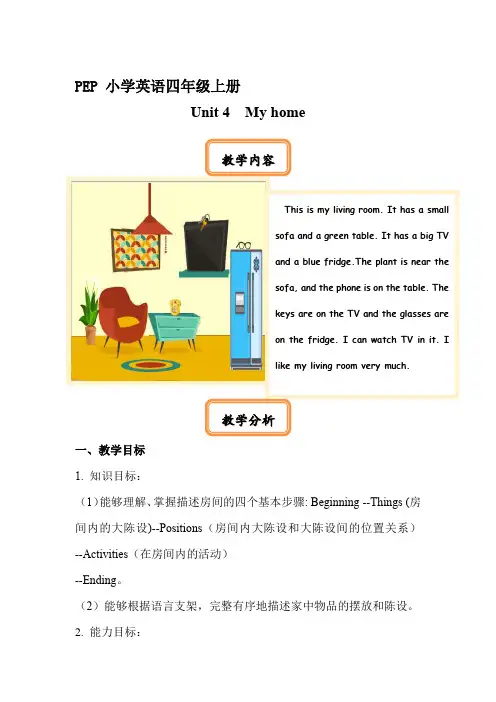
PEP 小学英语四年级上册Unit 4 My home教学内容This is my living room. It has a smallsofa and a green table. It has a big TVand a blue fridge.The plant is near thesofa, and the phone is on the table. Thekeys are on the TV and the glasses areon the fridge. I can watch TV in it. Ilike my living room very much.教学分析一、教学目标1.知识目标:(1)能够理解、掌握描述房间的四个基本步骤: Beginning --Things (房间内的大陈设)--Positions(房间内大陈设和大陈设间的位置关系)--Activities(在房间内的活动)--Ending。
(2)能够根据语言支架,完整有序地描述家中物品的摆放和陈设。
2. 能力目标:(1)能够对如何描述房间有了比较清晰、全面的认识。
(2)能够根据教师的引导,进行完整、有序地口语表达,并在表达时关注语言的逻辑顺序和句式结构。
3. 情感态度、学习策略目标:(1)通过本课的学习,培养和保持学生的英语学习兴趣。
(2)引导学生注重合作学习,培养合作、沟通、交流的意识和能力。
(3)培养学生爱自己的家、爱自己的家人的情感。
二、教学重难点分析1. 教学重点为根据描述房间的步骤,有序地、完整地描述房间中物品的摆放和陈设。
2. 难点为关于房间大陈设与小陈设之间位置关系的描述,即The...is/are..., and the...is/are...是本节课的难点。
三、课前准备CAI,Word cards教学过程What room is it? What’s in the rooms?扣,不仅复习了本单元的重点单词、句型,还激发了学生的学习兴趣,创建和谐快乐的课堂氛围。
PEP小学英语四年级上册nit4《MyHome》课堂教学实录.doc
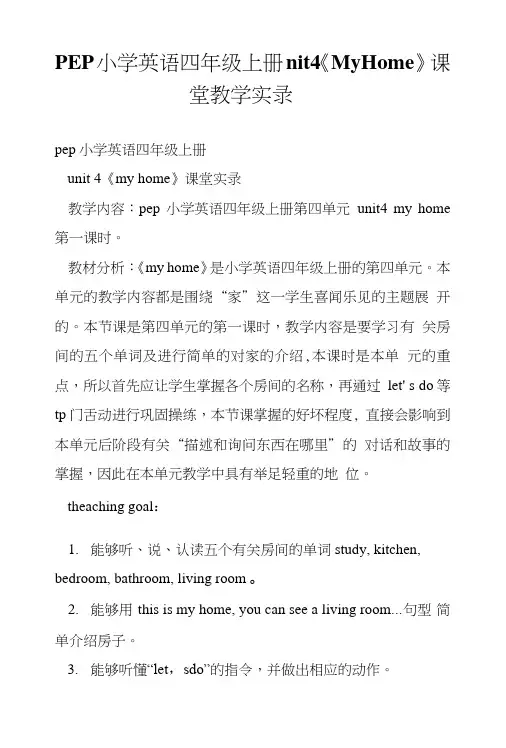
PEP小学英语四年级上册nit4《MyHome》课堂教学实录pep小学英语四年级上册unit 4《my home》课堂实录教学内容:pep小学英语四年级上册第四单元unit4 my home 第一课时。
教材分析:《my home》是小学英语四年级上册的第四单元。
本单元的教学内容都是围绕“家”这一学生喜闻乐见的主题展开的。
本节课是第四单元的第一课时,教学内容是要学习有关房间的五个单词及进行简单的对家的介绍,本课时是本单元的重点,所以首先应让学生掌握各个房间的名称,再通过let' s do等tp门舌动进行巩固操练,本节课掌握的好坏程度, 直接会影响到本单元后阶段有关“描述和询问东西在哪里”的对话和故事的掌握,因此在本单元教学中具有举足轻重的地位。
theaching goal:1.能够听、说、认读五个有关房间的单词study, kitchen, bedroom, bathroom, living room o2.能够用this is my home, you can see a living room...句型简单介绍房子。
3.能够听懂“let,sdo”的指令,并做出相应的动作。
4•培养学生对家的热爱,提高学生的口语表达能力和交际能力。
theaching key:熟练认读有关房间的五个单词。
theaching difficulty:单词bathroom, living room,白勺正确发曰Otheaching aid: cards tape recorder caitheaching method: tpr pairwork groupworktheaching stepsstep 1 warm-up1. good morning. boys and girls・ how are you nice to meet you. 's sing《in the classroom》,okstep 2 previewthe cai(door ,window) what,s this this is my home, there are many room are there do you visit my home now, let" s study unit4 《my home》.step 3 presentationl.(show the cai). this is my home, you can see a bedroom, a living room, a study ,a kitchen and a bathroom.,what,s this(客厅)there are five words on the blackboard,listen to me and guess, which word is "living room^teach^living room,'. there is a tv in the living room. what can you do in the living room teach^watch tv".chant "living roomjiving room, watch tv/53.(show the cai). .look ,what? s this(书房)listen to me and guess, which word is "study,,teach“study”・ there are many books in the study・ what can you do in the study teach^read a book,chant “study,study, read a book".4.(show the cai). look ,what" s this(厨房)listen to me and guess, which word is “kitchen',teach“kitchen". what can you do in the study teach^have a snack”.chant "kitchen 9kitchen,have a snack".5.(show the cai). look ,what" s this(bathroom) listen to me and guess, which word is "bathrooirTteach^bathroom". what can you do in the bathroom teach^take a shower”, chant "bathroom ?bathroom ,take a shower,6.(show the cai). .look ,what,s this(bed ) what,s this (room) what,s this (bedroom)teach u bedroom,\ there is a bed in the bedroom. what can you do in the bedroom teach6C have a sleep".chant "bedroom bedroom, have a sleep".to the tape and read after the tape・'s do.show the “go to the 二put the “living room, study , kitchen, bathroom, bedroom,9on, then t act “go to the living room, watch tv. go to the study, read a book. go to the kitchen,have a snack, go to the bathroom ,take a showe匚go to the bedroom, have a sleep”.now let" s do, ok follow me.step 4 practicenow, this group is team one, this group is team two. let, s go,ok 1 •炸出也雷:let" s play a game, ok who can read read together. your eyes, what' s missing guess, then tell us.Jook at the screen, guess, what" s this (show the cai ) the student guess.,this is my home,you can see a bedroom, a living room, a study ,a kitchen and a bathroom.who can do like me tell us what,s your room likethe students look and say.homework:your home to your prepare the u lets talk.”五、blackblard design:unit4 my homeliving room watch tvstudy read a bookkitchen have a snack bathroom take a shower bedroom have a sleep。
重大版小学英语四年级下册教(学)案(Unit 4)
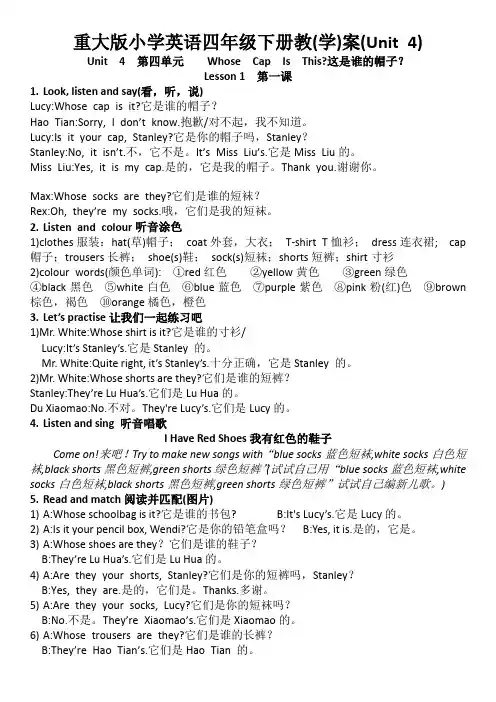
重大版小学英语四年级下册教(学)案(Unit 4) Unit 4 第四单元Whose Cap Is This?这是谁的帽子?Lesson 1 第一课1.Look, listen and say(看,听,说)Lucy:Whose cap is it?它是谁的帽子?Hao Tian:Sorry, I don’t know.抱歉/对不起,我不知道。
Lucy:Is it your cap, Stanley?它是你的帽子吗,Stanley?Stanley:No, it isn’t.不,它不是。
It’s Miss Liu’s.它是Miss Liu的。
Miss Liu:Yes, it is my cap.是的,它是我的帽子。
Thank you.谢谢你。
Max:Whose socks are they?它们是谁的短袜?Rex:Oh, they’re my socks.哦,它们是我的短袜。
2.Listen and colour听音涂色1)clothes服装:hat(草)帽子;coat外套,大衣;T-shirt T恤衫;dress连衣裙; cap 帽子;trousers长裤;shoe(s)鞋;sock(s)短袜;shorts短裤;shirt寸衫2)colour words(颜色单词): ①red红色②yellow黄色③green绿色④black黑色⑤white白色⑥blue蓝色⑦purple紫色⑧pink粉(红)色⑨brown 棕色,褐色⑩orange橘色,橙色3.Let’s practise让我们一起练习吧1)Mr. White:Whose shirt is it?它是谁的寸衫/Lucy:It’s Stanley’s.它是Stanley 的。
Mr. White:Quite right, it’s Stanley’s.十分正确,它是Stanley 的。
2)Mr. White:Whose shorts are they?它们是谁的短裤?Stanley:They’re Lu Hua’s.它们是Lu Hua的。
Unit 4 My home Read and write(学历案)四年级英语上册(人教PEP版)

Unit 4 My home B Let’s talk learn第三课时(学历案)四年级英语上册(人教PEP版)【学习目标】通过本课学习,我能够:1.通过观看视频、阅读文本,学生能够理解对话Where are the keys? Are they on the table? No, they aren’t.和词组sofa, bed, phone, table, fridge,正确回答问题。
(学习理解)2.通过模仿跟读、角色扮演等,学生能够用正确的读音、语调朗读对话,在情景中应用词组。
(应用实践)3.通过小组合作、课堂展示,能够在情景中恰当运用句型Where are the...? Are they on the...? Yes, they are. / No, they aren’t.流利地与别人谈论某人或某物的位置,形成良好的语言交际能力。
(迁移创新)【学习过程】table, fridge ,正确回答问题。
(学习理解)1.提出问题,引起学生的阅读兴趣。
播放对话,学生认真倾听,找出答案并展示。
Teacher: You are good atfinding.Let’s help John and his mother find their keys.Now listen and find. Where are their keys?2.讨论课文内容,帮助学生理解重点词汇及句式的意思,进而理解对话的内容。
Teacher: Are their keys on the table?(展示桌子的图片)Look,this is a table.(指向桌子)Is this a table? No,it's adesk. Are their keys on the table? No,they aren’t.(板书句式)Read after me,please. No,they aren’t. Are they near thephone?(出示电话图片) This is the phone. Read it one byone, please. Are the keys near the phone? No, they aren’t.Where are the keys? Yes, they are in the door. 用同样的方法教授词汇:bed, sofa, fridge教师根据学生理解词汇、拓展运用的情况,发现问题,及时提供帮助。
人教版四年级数学下册第四单元教学计划表
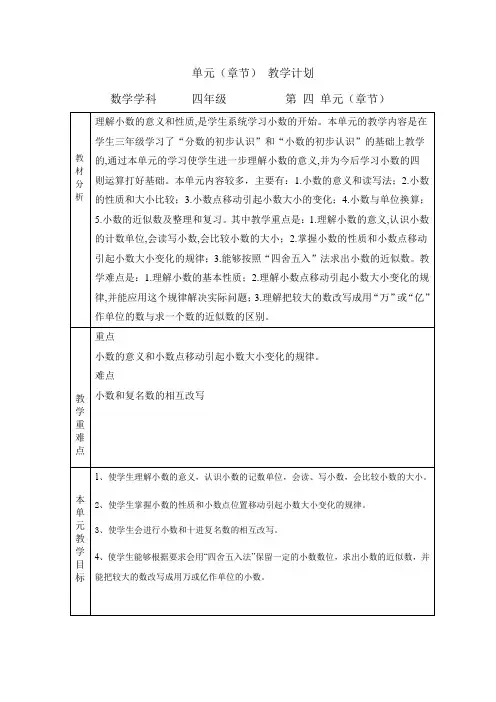
重点
小数的意义和小数点移动引起小数大小变化的规律。
难点
小数和复名数的相互改写
本单元教学目标
1、使学生理解小数的意义,认识小数的记数单位,会读、写小数,会比较小数的大小。
2、使学生掌握小数的性质和小数点位置移动引起小数大小变化的规律。
3、使学生会进行小数和十进复名数的相互改写。
4、使学生能够根据要求会用“四舍五入法”保留一定的小数数位,求出小数的近似数,并能把较大的数改写成用万或亿作单位的小数。
单元(章节ቤተ መጻሕፍቲ ባይዱ 教学计划
数学学科 四年级 第 四 单元(章节)
教材分析
理解小数的意义和性质,是学生系统学习小数的开始。本单元的教学内容是在学生三年级学习了“分数的初步认识”和“小数的初步认识”的基础上教学的,通过本单元的学习使学生进一步理解小数的意义,并为今后学习小数的四则运算打好基础。本单元内容较多,主要有:1.小数的意义和读写法;2.小数的性质和大小比较;3.小数点移动引起小数大小的变化;4.小数与单位换算;5.小数的近似数及整理和复习。其中教学重点是:1.理解小数的意义,认识小数的计数单位,会读写小数,会比较小数的大小;2.掌握小数的性质和小数点移动引起小数大小变化的规律;3.能够按照“四舍五入”法求出小数的近似数。教学难点是:1.理解小数的基本性质;2.理解小数点移动引起小数大小变化的规律,并能应用这个规律解决实际问题;3.理解把较大的数改写成用“万”或“亿”作单位的数与求一个数的近似数的区别。
单 元 教 学 进 度
周次
时 间
教学内容
课时
备注
【沪教版】四年级英语上册Unit 4《Do you have any cousins》教学案
【沪教版】四年级英语上册Unit 4《Do you have any cousins》教学案模块:Module 2 单元:Unit 4 话题:Do you have any cousins?单元教学概述教学目标:知识目标:1.掌握本单元的核心词汇,能正确书写。
2.能正确书写句子Do you have any cousins? Yes, I have one cousin.3.能正确读出字母e在闭音节中的发音。
语言技能:1.听懂询问别人家庭情况的对话。
2.能用句型Do you have any …? 询问别人的家庭成员情况。
用I have …介绍自己的家庭成员情况。
3.阅读家谱,理解家庭成员之间的关系。
情感态度目标:利用多种游戏或活动形式培养学生对英语学习的浓厚兴趣。
教学重难点:重点:1.掌握词汇any,cousin,family,parents,grandfather,grandmother,uncle,aunt,that2.能用Do you have any cousins? Yes, I do. /No, I don’t.谈论家庭成员情况。
3.了解字母e在闭音节中的发音难点:any在否定句和一般疑问句中的用法,以及some在肯定句中的用法。
教法策略分析:通过以旧带新的方式学习新词。
通过朗读课文,复述课文,和扩展阅读材料,给学生提供更多接触英语、运用英语的机会。
运用评价机制激发学生学习兴趣,增强竞争意识。
课时划分:三课时教学课时分配: 第一课时:Look and learn, Culture corner第二课时:Listen and say, Do a survey第三课时:Say and act, Learn the sounds课题:Unit 4 Do you have any cousins?教学课时:第一课时教学内容:Look and learn, Culture corner教学目标知识目标:1.帮助学生学习掌握Look and Learn 中表示家庭成员的单词。
四年级英语上册 Unit4 Do you have any cousins教案 沪教牛津版(三起)
Do you have any cousins?
parent,
grandfather, grandmother,
grandparent,
uncle, aunt, cousin
☆补充设计☆
作 业 设 计
教 学 后 记
课 题
Do you have any cousins?
课型
第 几
课时
第二课时
S3: Do you have any uncles and aunts?
S2: Yes, I have two uncles and three aunts
SI: (have Picture A) Do you have any aunts?
S2: (have Picture B)Yes,I have one aunt.
grandfather.
然后,指着家谱图中的人物图片说单词,让学生快速反应。
T: (point to Jill's aunt) Uncle?
2.在黑板上画出Jill的家谱图,请学生上来把单词卡片贴在适当的位置上,贴完之后让全班一起拼读单词。接着教师介绍Jill的家庭成员。
T. (point to the family tree) Jill has one uncle.His name's John. He's Jill's mother's
SI: (point to his ph oto) This is a photo of myfamily. They're my parents. They're my
grandparents. I have one uncle. His name's
四年级上册英语导学案-Unit4MyHome
四年级上册英语导学案——Unit 4 My Home. A Let’s spell(人教版PEP)一、教学目标1. 知识目标(1)能够听懂、会说、会读单词“home, family, room, kitchen”等,并能够运用到实际情景中。
(2)能够听懂、会说、会读句子“What’s this? It’s a/an”以及回答“It’s my”等。
(3)掌握字母组合“ome”的发音规律,能够辨别并正确发音相关单词。
2. 能力目标(1)能够正确书写句子,描述自己的家庭和家居环境。
(2)能够通过图片或实物,进行简单的英语交流,介绍自己的家和家庭成员。
3. 情感目标培养学生的家庭观念,让他们学会关爱家人,珍惜家庭和谐。
二、教学内容1. 单词:home, family, room, kitchen2. 句子:What’s this? It’s a/an, What’s that? It’sa/an, It’s my3. 字母组合:ome三、教学重点与难点1. 重点:单词“home, family, room, kitchen”的认读和运用,句子“What’s this?It’s a/an”以及回答“It’s my”的运用。
2. 难点:字母组合“ome”的发音规律,以及相关单词的拼写。
四、教具与学具准备1. 教具:图片、卡片、课件等。
2. 学具:课本、练习册、单词卡片等。
五、教学过程1. 导入:利用图片或实物,引导学生谈论自己的家庭和家居环境,为新课的学习营造轻松的氛围。
2. 呈现:通过课件或实物,展示单词“home, family, room, kitchen”,让学生听音辨物,并学会用英语描述。
3. 学习:引导学生通过观察、模仿、实践,掌握字母组合“ome”的发音规律,并正确发音相关单词。
4. 练习:通过小组活动、游戏等方式,让学生充分练习单词和句子的运用,巩固所学知识。
5. 运用:让学生结合自己的生活实际,用英语描述自己的家庭和家居环境,提高学生的语言运用能力。
人教精通版四年级上册英语 unit 4单元教学设计表格式教案
Lesson 19一、教学目标1.引导学生在真实的语境中运用It's fine today. It’s nice today.等语句描述天气,能用Let’s…语句提出请求,并能进行简单的对话交流。
2、在教学活动中引导学生在愉悦的学习氛围中学会单词:kite,nice,fine(听、说、读,写nice,fine)。
3、学习并表演欢快有节奏的歌谣,巩固所学知识。
二、教学重点1、正确听、说、读、写单词nice,fine2、能够在情境中理解、会说、会用It's fine today. It’s ni ce today.等语句描述天气,能用Let’s…语句提出请求,并能进行简单的对话交流。
三、教学难点:理解、会说、会用It's fine today. It’s nice today.等语句描述天气,能够在真实语境中进行对话交流。
四、课前准备1.准备Mimi、Micky头饰。
2.准备足球(皮球)、风筝图片、晴朗的天气图片。
3.录音机等必用教具。
五、教学过程:1.Warm-up日常口语练习,进行简短对活。
2.Presentation(1)导入对话。
教师拿出风筝图片。
问Micky:What's this in English? 答:It's a kite.:Yes. Kite,kite,a very nice kite!同时板书:kite,并引导学生用手指空写,边写边说。
学生两人—组轮流练习.S1:What's that in English?S2:It's a kite,a very nice kite,教师戴上Mimi头饰说:Hi, Micky! It’s fine today. Let’s play with my kite. 边说边做动作,教师又扮成Micky 问答:Great!注意:Let’s… 说活人邀请别人与自己—起干某事。
接受别人邀请可以说:Great/Good idea. /OK. Let’s go! 邀请别人一起踢球:Let's play football.学生两人一组,戴上Mimi和Micky头饰,练说对话。
- 1、下载文档前请自行甄别文档内容的完整性,平台不提供额外的编辑、内容补充、找答案等附加服务。
- 2、"仅部分预览"的文档,不可在线预览部分如存在完整性等问题,可反馈申请退款(可完整预览的文档不适用该条件!)。
- 3、如文档侵犯您的权益,请联系客服反馈,我们会尽快为您处理(人工客服工作时间:9:00-18:30)。
学校
长庆泾渭小学
科目
英语组别综合组时间2014.12.23
中心发言人
吴娟莉
单元题目
Unit4 My home
中心发言记录
教材分析:
本单元以animal为话题,分A,B,C三部分。以A,B部分Let’s learn中的十个颜色单词为线索,Let’s talk为桥梁,C部分中的任务活动为中心,贯穿整个单元。A,B部分let’s learn为词汇教学,内容为是个房间的单词。A,B部分let’s talk为句型教学,内容为日常交话在学习新知识的同时,落实任务型教学,将形式多样的任务活动。
学情分析:
四年级的学生,生性活泼好动,喜欢直观形象思维,对游戏,画画特别感兴趣,教师在这一阶段的重要任务在于激发并保持学生学习英语的兴趣。这一单元所学的知识是关于动物的话题,这是学生们非常感兴趣的一个话题,在教学过程中要运用手势语进行教学,通过手势扮演各种动物,以此来加深学生对动物单词的记忆。
教情分析:
赵老师:这一单元是关于home的话题,可以通过TPR活动来练习和巩固单词,可以先要求学生仔细看图片,
曾老师:四年级年级的小学生天生好动,可以利用work in pairs,in three,in row,in group等多种形式操练和巩固所学句型。
吴老师:本单元还可以采取愉快教学的课堂教学模式,运用学生的直观感觉,帮助学生理解对话。
2、情景教学法:情景是教师创设或模拟的生活场景,应具有真实、生动、实用的特点,便于学生将所学语言材料进行综合、创造性地进行表达交流。这种练习方法,有接近生活的交际功能,而且能变单调、机械的句型操练为活泼、生动的交际性练习。
3、动作教学法:在低年级英语教学中,用具体形象的手势、动作来辅助英语学习,激发学生学习兴趣,提高学习效果。
能力训练:
1.能够简单描述自己的家,并能介绍各个房间及室内家具;
2.能够询问猜测物品的位置,并能做出相应的回答;
3.能够听懂并发出一些指令;
4.会唱歌曲“My Bedroom”。
情感、策略、文化等有关目标:
1.培养学生对家的热爱,鼓励学生大胆设想自己未来家居;
2.培养学生互相帮助团结合作的精神;
3.了解西方国家的房屋结构及部分名称。
Ss: Yes.
T: Take your pictures and introduce your home with your partner.(多媒体出示师示范语言,学生同桌介绍自己的家。)
T: Now, who can introduce your home to the whole class?(请部分学生向全班介绍自己的家。)
4、活动教学法:就是按照学生身心发展过程中的不同阶段来设计、布置情境,提供材料,让学生积极参与自由操作、观察思考。通过活动让学生自己认识事物、发现问题,得出答案。
5、发全身反应法:调动学生的感觉器官,让学生通过全身各个部位的不同动作达到记忆的目的。掘学生潜能。
学法:学生主要通过观察与思考、归纳总结活动与游戏应用等方法积极主动地参与到教与学的过程中来并达成学习目标。拓展延伸:1.介绍自己的家
四会单词是:home room school door window desk chair共8个单词。
在教学中注意适时帮助学生了解home\house和desk\table的区别
本单元对话教学中要注意先复习三年级下册第五单元与本册学生用书第一单元中句型Where is ...? It’s in\on\under\near...作为铺垫,减轻教与学的难度。
Please introduce your home to your friends.
学科负责人:检查人:检查日期:
3.Let’s check,总结落实课,通过对听力理解评价,检查学生落实情况。
同科参议记录
李老师:在这一单元中,可以采用情景表演的方式,喜爱表演是小学生的天性,可以充分利用这一特性让学生用自己所带的毛绒动物表演对话内容,给学生充分的时间与同伴练习本课重点句型,让学生通过表演,真正锻炼其运用语言的能力。
教师是教学活动中的引导者,学生才是教学活动的主体,教师应该在教学活动中积极主动的引导学生,不断培养学生的质疑能力,努力地让学生将课本上的内容与生活实际相联系,在玩中学,在学中玩。
课型设计:
1.Let’s talk,会话教学,创设真实情景授新,利用动物玩偶和课件,让学生操练和使用句型。
2.Let’s learn,单词教学,在熟练掌握五个动物单词的基础上,通过let’s learn来巩固和操练单词。
重点解读:本单元的教学重点是有关房屋及室内家具的英语表达和一般疑问句用法。教学难点:一般疑问句正确运用及其回答。
难点分散:在教授主要句型的时候要合理的分配在不同的课时中,在情境中学习语言,运用语言。
教法与学法:
教法:1、游戏教学法:用游戏形式复习单词、句型,练习新语言点,使学生寓学于乐,在活泼、轻忪、愉快的气氛中自然而然地获得英语知识与技能。游戏要求简短易行,有趣味,而且要与本课教学内容紧密相关。
达成共识
鉴于本单元以my home为话题,特别贴近学生生活实际,在教学中我们可以运用多种教学方式,例如:情景教学法,TPR教学法,听力操练法等多种方法来操练和巩固单词,还可借用图画,视频等多媒体,愉快教学,让学生在形象直观的理解下,有效地消化所学内容,可以创设情景,营造氛围,表演对话,进而帮助学生习得相关的语言。在学习语言的过程中,培养学生的合作意识,进一步提高学生学习英语的兴趣,寓教于乐。
形成共案
基础知识、能力训练、重点解读、难点分散、教法学法、拓展延伸
基础知识:本单元的中心内容是我的家,学习各个房间及部分室内家具摆设的名称、特征,能对物品位置进行问答。主要句型是:1:This is my home.2:Where is ......?Where are...? 3:Is it(Are they) in\on\under...? Yes,it is(they are).No,it isn’t(they aren’t).
目标分析:
本单元的中心内容是我的家,学习各个房间及部分室内家具摆设的名称、特征,能对物品置进行问答。主要句型是:1:This is my home.2:Where is ......?Where are...? 3:Is it(Are they) in\on\under...? Yes,it is(they are).No,it isn’t(they aren’t).四会单词是:home room school door window desk chair共8个单词。本单元对话教学中要注意先复习三年级下册第五单元与本册学生用书第一单元中句型Where is ...? It’s in\on\under\near...作为铺垫,减轻教与学的难度。
T: Well done! Now, please walk around the class and introduce your home to your friends.(学生在教室自由走动,向朋友介绍自己的家。)
(学生的感情升华,同时发挥孩子的想象力,培养孩子对家和生活的热爱。)
Step5.homework:
形成共案
基础知识、能力训练、重点解读、难点分散、教法学法、拓展延伸
拓展延伸:
1.介绍自己的家
T: (多媒体出示一张新的home图。)Look, boys and girls, this is my new home. You can see a living room, a…. I can watch TV in the living room, I can read a book in the study…. Can you introduce your home now?
